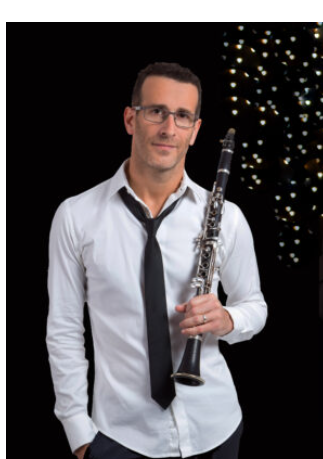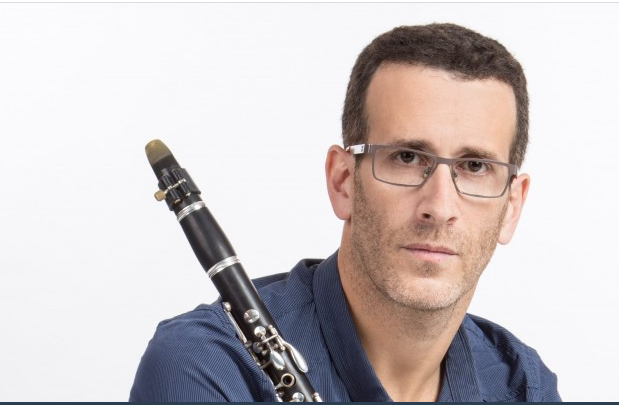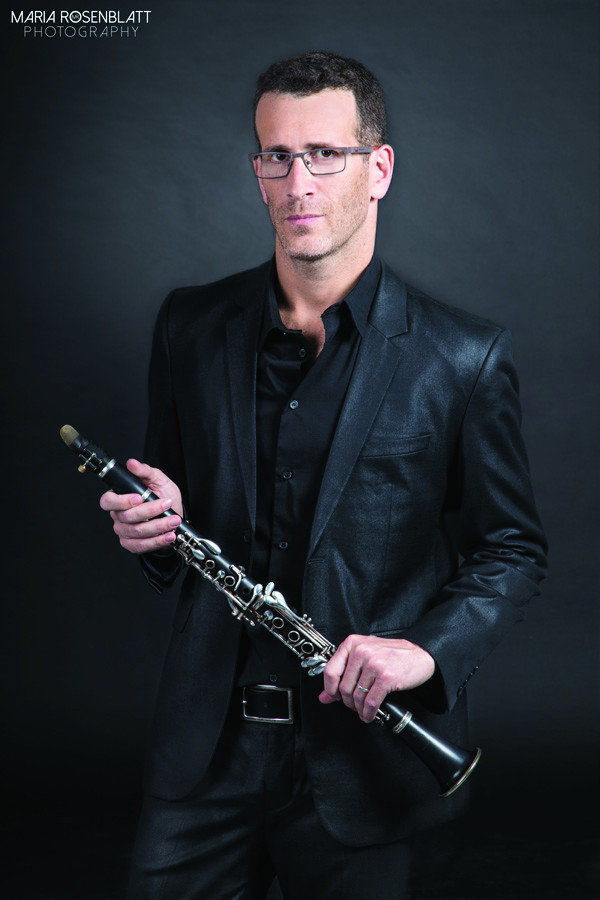I was weaned on Benny Goodman by listening to my mother’s youngest brother as he tried to emulate BG. From those early days my love of the clarinet grew. Sadly, the ability to play music did not.
Over the ensuing eighty years it has been my good fortune to experience many great clarinetists live. Monty Sunshine and Cy Laurie in my London days; George Lewis, Willie Humphrey, Barney Bigard, Woody Herman, Kenny Davern, Alan Vache as well some younger performers such as Dave Bennett, Joe Goldberg, and Dan Levinson. I mention all of these because in my many years of listening, I have never quite met a clarinetist quite like Gilad Harel.
Whether it’s Swing, New Orleans trad, Klezmer, Baroque, Mozart, Gilad Harel’s versatility in many genres amazes. Even more remarkable, he is a true virtuoso in each. The sound, the lyricism, the rhythm, the technique that flows from his clarinet is astonishing. Playing a classical concert in Europe or Asia or parading his New Orleans trad band through ancient Jaffa, his playing is superb. For me, above all, is his interpretation of both Benny Goodman and Giora Feidman.
This current interview was originally initiated after enjoying a live performance of his New Orleans Function band, billed as “Dixieland meets Klezmer.” Klezmer is generally defined as an instrumental musical tradition of Central and Eastern European Jews, including dance tunes, ritual melodies, and virtuosic improvisations.
That was November 2019 just before the onset of Covid. Three years later I finally caught up with Gilad, who lives in Israel, to learn the background for his combining these two genres, which have been part of my life since early childhood. In the meantime, I had also discovered, through YouTube, his prowess in the other genres.
FF: Why this fascination with Swing and Klezmer?
GH: The very first recorded clarinet I ever heard, at the age of seven, was a record of Giora Feidman, the great Klezmer clarinetist. A year later I received a Benny Goodman record. These two were my best companions for many years to come! Many years later I met Giora and played with him. We have had a good relationship since then.
Giora Feidman, a virtuoso clarinetist, led a revival for “Klezmer” in the 1970s. Feidmans’s revival of this Jewish music can be compared to what “Riverdance” did for Irish Celtic music.
The two styles, both Benny and Giora, are strongly ingrained in my DNA and touch me in the deepest places. Much more so than classical music, which became my official training.
My mother, who gave me both of those discs, was a classical pianist. Her influence led to me enrolling in the Juilliard School in New York as well as the Paris National Conservatory.
I always kept on playing Klezmer and, while living in New York, found ways to combine it with different styles but I never thought of “Klezmer Swing” until I came upon certain recordings of Dave Tarras.
Tarras, in the 1920s, was a great Klezmer musician who tried to combine Klezmer with swing. At the time the stories of the musicians were quite similar—migrants to New York who had to learn to live new lives in new places, trying to, on one hand recreate their former lives and, on the other hand to assimilate, both in their everyday lives and in their cultural lives.
The Dave Tarras Orchestra made numerous New York City radio appearances, starting in the 1930s. It is conservatively estimated that he participated in 500 recordings during his career. Tarras was recognized for creating “a new Klezmer sound that fused popular American music with recognizable European roots.” His most enduring recording Tanz! (1956) successfully combines jazz and Klezmer idioms.
Tarras worked closely with his son-in-law, Sam Musiker, who was Gene Krupa’s sax player. Musiker did most of the swing arrangements for Tarras. During Tarras’ successful days in New York, he had a weekly radio show called Jewish American Music for which he created with Musiker on many beautiful tracks. You can easily find them on Spotify.
So The New Orleans Function Band project was to “dress up” Tarras’ music with the rhythms of New Orleans Swing and Trad Jazz?
Yes, later I learned that Tarras, along with Goodman’s trumpet player Ziggy Elman, were the first to combine the two genres.
Goodman recorded both “Bei Mir Bist Du Schoen” and “When The Angels Sing” with Elman starring on both recordings. However, aside from Tarras’ records, I don’t know of any others who combined Klezmer with Swing.
“Bei mir bist du schön” was a popular Yiddish song of the 1930s. Later English lyrics were written by Sammy Cahn and Saul Chaplin and it became a worldwide hit when recorded by The Andrews Sisters. “When The Angels Sing” with Elman starring on both recordings includes elements of Klezmer. It can be heard at the famous Carnegie Hall concert.
Did Tarras play Dixie?
The combination with Dixieland is purely mine. I never heard anyone else doing it. It is the result of my encounter with the New Orleans Function Band exactly at the time I began dreaming about a tribute to Tarras—one combining my two favorite styles.
How did you become involved with the New Orleans Function band?
I met Arnon De Botton when both of us played for several weeks in the house band at Tel Aviv’s Cameri theatre. Arnon is an outstanding trombonist. My childhood friend, Kobi Solomon (another BG style clarinetist), had formed the NOF band, with Arnon and Eli Preminger.
I remember a street session you all did, marching through streets and alleyway of Old Jaffa, with my wife and I making up the second line!
Is it possible to make a “blend”? As a non-musician, to my ear Klezmer seems to draw from the same roots as Gypsy music while New Orleans Trad jazz seems to be more rooted in African rhythms and Southern blues/gospel. At your session, “Dixie Klezmer” at the Jacob’s Ladder Festival in Israel, I was hearing mostly Klezmer.
When I played you heard Klezmer, when Kobi and the others played you heard Dixie! I believe the two styles relate to each other even better than the swing combination. Swing music is mostly off the beat while Dixie, like Klezmer, is mostly on the beat.
Many of the composers of “The Great American Songbook” were Jewish. Does their music have its roots in Klezmer and other Jewish folk music?
No, I don’t hear that. Their work was mostly for stage and film musicals. Even the score of Fiddler On The Roof, set in a East European Jewish village, had little that was Klezmer.
However, much of the work of those great composers has served as the melody line for some of the finest jazz ever played. They continue to this day to provide inspiration. Some of the compositions even morphed into other tunes.
An excellent example of this is provided by Benny Goodman, in a rare video,
explaining how “Rose Room” morphed into “In A Mellow Tone” and “How High The Moon” became Charlie’ Parker’s “Ornithology.”
There is a story behind the “Rose” tune. Apparently, just before a concert it was discovered that copyright rules didn’t allow for playing “Rose Room,” so they improvised it into “In A Mellow Tone!”
On YouTube, I discovered your beautiful interpretation of Hoagy Carmichael’s “Stardust” played with quartet at the Felix Blumenthal Music Center in Tel Aviv. Tell me more about that concert where you also performed with a larger orchestra under the baton of Guy Felder?
Glad you enjoyed it. The concert was dedicated to clarinet compositions by Stravinsky (Ebony Concerto), Morton Gould (Derivations), and Bernstein (Prelude, Fugue and Riffs). I decided to treat the audience to some BG quartet numbers!

Your versatility is quite amazing. From the discography on your web site, you are at home in many genres. You recorded with the Paragon Ragtime Orchestra for their Black Manhattan disc and joined Cuban-born, Roberto Rodriquez in several videos and recordings. Your library of videos on YouTube is notable for the variety of genres. In this you follow Benny’s classical works and Giora who was a mainstay with the Israel Philharmonic Orchestra over 20 years. You are equally at home whether it is marching through the alleyways of Jaffa, giving a master class or being the featured soloist at major concert halls in Berlin, Paris, Hong Kong, and Taiwan among others.
It really becomes part of one’s DNA. The brain can switch effortlessly. Music is a language.
You recorded several discs with Roberto Rodriquez. Do you feel any relationship to Klezmer in his music? Your clarinet in his composition “Zahabriel” while clearly Latin does have flavors of Klezmer.
Rodriquez, born in Cuba, grew up in Miami and now lives in New York. His music is very definitely Cuban jazz. Like all jazz the emphasis is improvisation. His Timba Talmud disc does have elements of Klezmer.
Israel is a small country, with so many good musicians—why?
Good teachers!
The large number of Israeli Jazzmen in USA – any comments?
New York is a melting pot for Jazz. The finest musicians at one time or the other play there. In my student years there and after, I was exposed to many genres.
Where is your emphasis today?
I am not a jazz musician playing classical but rather the opposite—a classical who loves the improvisation of jazz. Wherever I play classical concerts I try to add some Klezmer to the program. The audiences always react very positively.
You are also a teacher?
Yes, I am on the faculty at the Jerusalem Academy of Music and at the Israeli Conservatory of Music in Tel Aviv. I also give masterclasses and Klezmer workshops around the world.
Thank you Gilad.
I end with excerpts from a review of a Hong Kong concert …. “The sublime simplicity of Mozart’s Adagio never ceases to amaze, and in Harel’s hands, the ethereality moved to another dimension. The “Klezmer’s Smile’’ was certainly a leap from Mozart’s world…. Harel’s clarinet took on a new guise here, brilliantly show casing his familiarity with the sighing melancholy and the rougher edges associated with Eastern European Jewish folk melody.”
Follow Gilad on his excellent web site, www.giladharel.net. Like his playing, it is first-class, giving an insight into the varied sides of this talented musician.
Frank Farbenbloom is a traditional jazz supporter based in Israel.






















